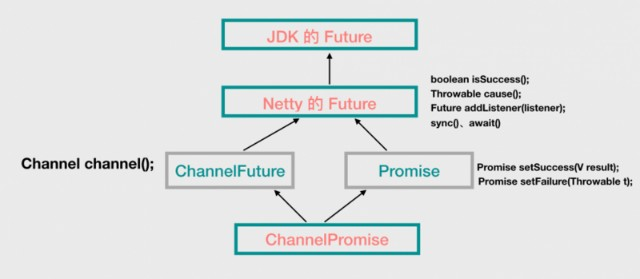
Promise是可写的future,从future的分析中能够发如今其中没有写操做的接口,netty特地使promise扩展了future,能够对异步操做结果进行设置。
(一)defaultpromise
包含的字段:
//原子保存异步操做结果 private static final AtomicReferenceFieldUpdater<DefaultPromise, Object> RESULT_UPDATER = AtomicReferenceFieldUpdater.newUpdater(DefaultPromise.class, Object.class, "result"); //异步操做结果 private volatile Object result; private final EventExecutor executor;
操做结果通知
为了可以支持异步地获取操做结果,netty中用通知的方式来对后续的listener中的操做,操做结果等进行控制。通知的前提包括success,fail,cancel三种状态。数组
1. success状态:setsuccess()方法
- 第一步:异步操做结束调用setSuccess(V result)或trySuccess(V result)
方法,将操做结果当作参数传入,来通知能够对结果进行使用。
public Promise<V> setSuccess(V result) { if (setSuccess0(result)) { //触发listener中的operationcomplete()方法 notifyListeners(); return this; } throw new IllegalStateException("complete already: " + this); }
- 第二步:首先调用setsuccess0()方法对result变量进行保存,若是保存成功则经过notifyListeners()触发listener中的operationcomplete()方法。
#setsuccess0()方法: private boolean setSuccess0(V result) { return setValue0(result == null ? SUCCESS : result); } #setvalue0()方法: private boolean setValue0(Object objResult) { if (RESULT_UPDATER.compareAndSet(this, null, objResult) || RESULT_UPDATER.compareAndSet(this, UNCANCELLABLE, objResult)) { checkNotifyWaiters(); return true; } return false; }
注意:在success状态下保存结果时,若是result(异步操做结果)为null,则将promise内部的result设置为常量SUCCESS。再者,在promise的result中,只容许保存一次,因此netty采用cas保证结果只保存一遍,若结果保存出错返回false。
#SUCCESS常量 private static final Signal SUCCESS = Signal.valueOf(DefaultPromise.class.getName() + ".SUCCESS");
- 第三步:保存完结果后,通知全部同步等待异步操做结果的线程。
private synchronized void checkNotifyWaiters() { if (waiters > 0) { notifyAll(); } }
2. success状态:trysuccess()方法源码分析
trysuccess()方法与setsuccess()方法大同小异,只不过在保存结果出错的时候,返回false,而setsuccess()抛出一个异常信息。
public boolean trySuccess(V result) { if (setSuccess0(result)) { notifyListeners(); return true; } return false; }
3.fail状态:线程
fail状态下通知机制和success几乎相同,区别在于保存异步操做结果的时候,fail状态保存的是使用CauseHolder进行封装的异常信息对象。
private boolean setFailure0(Throwable cause) { return setValue0(new CauseHolder(checkNotNull(cause, "cause"))); }
4.cancel状态:
cancel状态,表示异步操做的时候,对promise对象进行了cancel操做。
public boolean cancel(boolean mayInterruptIfRunning) { if (RESULT_UPDATER.compareAndSet(this, null, CANCELLATION_CAUSE_HOLDER)) { checkNotifyWaiters(); notifyListeners(); return true; } return false; }
一样的,cancel后也和success和fail同样,对result进行了设置。在success的时候,容许初始值为null和UNCANCELLABLE常量(表示不容许cancel),在cancel状态只容许为null。
# CANCELLATION_CAUSE_HOLDER //封装了CancellationException异常。 private static final CauseHolder CANCELLATION_CAUSE_HOLDER = new CauseHolder(ThrowableUtil.unknownStackTrace( new CancellationException(), DefaultPromise.class, "cancel(...)"));
5.操做结果通知总结:
首先,经过调用setsuccess()等方法,启动通知机制;
而后,将异步操做结果进行保存,仅容许保存一次,不然会返回false.
保存好信息后,触发listener中的操做,还会通知全部同步等待异步操做结果的线程。
添加监听者
接下来分析promise如何添加监听者。
(一). 首先来看一下用来保存监听者对象的字段。
/** * One or more listeners. Can be a {@link GenericFutureListener} or a {@link DefaultFutureListeners}. * If {@code null}, it means either 1) no listeners were added yet or 2) all listeners were notified. * * Threading - synchronized(this). We must support adding listeners when there is no EventExecutor. */ private Object listeners;
从注释能够总结出那么几个信息:
1.这个object类型的listeners字段,能够是GenericFutureListener类型,也能够是link DefaultFutureListeners(用来保存GenericFutureListener的数组)。 ps:这样设计的好处,多数状况下,listener只有一个,用集合或者数组会形成浪费,只有真正须要多个监听者的时候,才使用数组 2.若是listeners为null,表示还未添加监听者或者已经触发过了(一旦触发就会将listeners清空) 3.能够在外部添加监听者,因此使用加锁的形式(synchronized(this))添加监听者。
(二). 添加监听器的过程
@Override public Promise<V> addListener(GenericFutureListener<? extends Future<? super V>> listener) { checkNotNull(listener, "listener"); synchronized (this) { addListener0(listener); } if (isDone()) { notifyListeners(); } return this; }
用加锁的方式添加监听器,添加完成后,若是promise的状态为isdone,就会当即触发Listener。接下来看看addlistener0()是如何添加的。
private void addListener0(GenericFutureListener<? extends Future<? super V>> listener) { if (listeners == null) { listeners = listener; } else if (listeners instanceof DefaultFutureListeners) { ((DefaultFutureListeners) listeners).add(listener); } else { listeners = new DefaultFutureListeners((GenericFutureListener<? extends Future<V>>) listeners, listener); } }
listeners字段只多是GenericFutureListener类型,或者DefaultFutureListeners类型。因此若是为Null,直接保存;若是已是DefaultFutureListeners(数组形式),就让其再添加一个listener;若是是GenericFutureListener类型,就建立一个数组。
(三)DefaultFutureListeners类分析:
首先看看它的构造方法:
DefaultFutureListeners( GenericFutureListener<? extends Future<?>> first, GenericFutureListener<? extends Future<?>> second) { listeners = new GenericFutureListener[2]; listeners[0] = first; listeners[1] = second; size = 2; if (first instanceof GenericProgressiveFutureListener) { progressiveSize ++; } if (second instanceof GenericProgressiveFutureListener) { progressiveSize ++; } }
能够看出,从构造之初,他就是size为2的数组。
再来看看它是如何在后续过程当中添加元素的:
public void add(GenericFutureListener<? extends Future<?>> l) { GenericFutureListener<? extends Future<?>>[] listeners = this.listeners; final int size = this.size; if (size == listeners.length) { this.listeners = listeners = Arrays.copyOf(listeners, size << 1); } listeners[size] = l; this.size = size + 1; if (l instanceof GenericProgressiveFutureListener) { progressiveSize ++; } }
若是数组容量未满,就继续添加元素;若是数组容量已满,就将容量翻倍,将原数组内容复制拷贝到新数组中。
(四)添加监听者总结:
1.添加完监听者,就会尝试去触发listener中的操做。
2.promise内部用来保存监听者的listeners只会是两种类型,GenericFutureListener类型和link DefaultFutureListeners。
触发监听者
在前面的setsuccess()和addlistener()等方法中均可以看到notifylisteners()方法,这就是触发监听者的起点。
private void notifyListeners() { EventExecutor executor = executor(); if (executor.inEventLoop()) { …… notifyListenersNow(); …… } safeExecute(executor, new Runnable() { @Override public void run() { notifyListenersNow(); } }); } private static void safeExecute(EventExecutor executor, Runnable task) { executor.execute(task); …… }
在notifylisteners()方法中,能够看到,listener中触发的异步操做要求是在线程组中执行的,若是是在线程组外部提交的任务,会将任务封装成runnable提交到任务队列中等待执行。
接下来看看notifynow()方法中作了什么。
private void notifyListenersNow() { Object listeners; synchronized (this) { // Only proceed if there are listeners to notify and we are not already notifying listeners. if (notifyingListeners || this.listeners == null) { return; } notifyingListeners = true; listeners = this.listeners; this.listeners = null; } for (;;) { if (listeners instanceof DefaultFutureListeners) { notifyListeners0((DefaultFutureListeners) listeners); } else { notifyListener0(this, (GenericFutureListener<? extends Future<V>>) listeners); } synchronized (this) { if (this.listeners == null) { // Nothing can throw from within this method, so setting notifyingListeners back to false does not // need to be in a finally block. notifyingListeners = false; return; } listeners = this.listeners; this.listeners = null; } } }
在该方法中,首先将Listeners取出来,而后将其清空(每次触发完listeners都会将原来的listeners清空),而后执行listener中具体的操做,执行完操做,会再次检查是否又有listeners添加进来,确保无误后,从方法中退出。
private static void notifyListener0(Future future, GenericFutureListener l) { try { l.operationComplete(future); } catch (Throwable t) { logger.warn("An exception was thrown by " + l.getClass().getName() + ".operationComplete()", t); } }
触发监听者总结:
1.触发的listeners中具体的操做是在线程池中进行
2.触发完毕的listeners会将其清空。
同步等待
netty还提供了接口能够同步等待异步操做结果,使用到的是await()和sync()方法。
public Promise<V> await() throws InterruptedException { if (isDone()) { return this; } if (Thread.interrupted()) { throw new InterruptedException(toString()); } checkDeadLock(); synchronized (this) { while (!isDone()) { incWaiters(); try { wait(); } finally { decWaiters(); } } } return this; }
原理很简单,就是让线程在promise对象上等待通知。若是是isdone状态,就直接返回。
sync()方法是在await()方法的基础上添加了额外的功能,区别只是sync()调用,若是异步操做失败,则会抛出异常。
public Promise<V> sync() throws InterruptedException { await(); rethrowIfFailed(); return this; }
(二)defaultchannelpromise
ChannelPromise 接口在 Netty 中使用得比较多,它综合了 ChannelFuture 和 Promise 中的方法,只不过经过覆写将返回值都变为 ChannelPromise 了而已,没有增长什么新的功能。

从defaultpromise的分析能够得知,listener中的操做是由线程池来执行。但注意到defaultpromise的其中一个权限为protected的构造方法不须要传入eventexecutor,这可能致使出现nullpoint异常。
因此出现了另外一个扩展类,defaultchannelpromise。
public DefaultChannelPromise(Channel channel) { this.channel = checkNotNull(channel, "channel"); } public DefaultChannelPromise(Channel channel, EventExecutor executor) { super(executor); this.channel = checkNotNull(channel, "channel"); }
defaultchannelpromise类有两个构造方法,一个为父类传入eventexecutor,一个调用的是上面提到的父类中protected的构造方法。
protected EventExecutor executor() { EventExecutor e = super.executor(); if (e == null) { return channel().eventLoop(); } else { return e; } }
能够看到,当eventexecutor为Null时,保存的是channel中的eventexecutor。
参考:
https://segmentfault.com/a/1190000013016083
https://segmentfault.com/a/1190000022519340